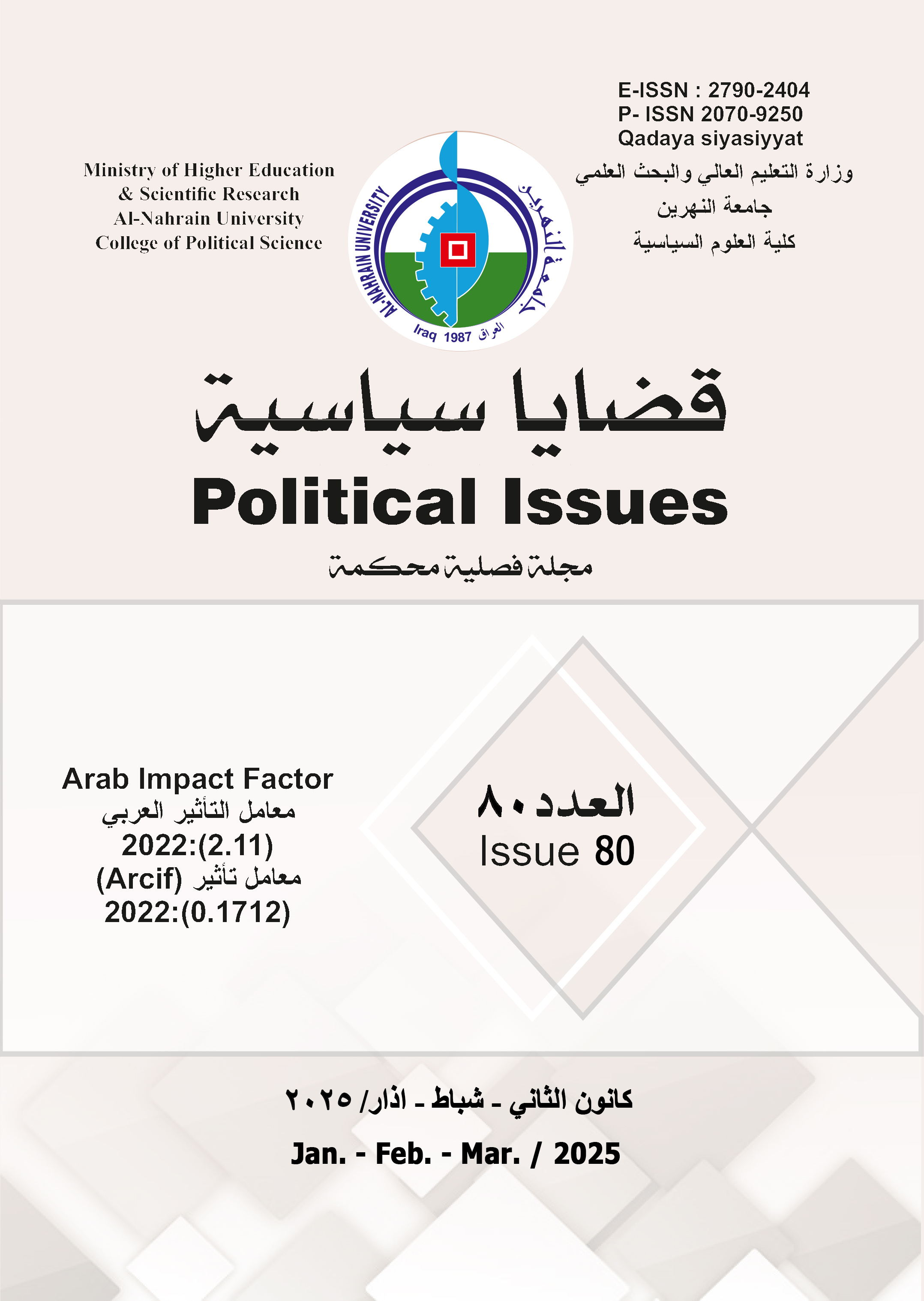التداول المزدوج في الصين: آفاق جديدة للتجارة الدولية في ظل التوترات التجارية والسياسات الحمائية
DOI:
https://doi.org/10.58298/802025698الكلمات المفتاحية:
التداول المزدوج، الصين، الحمائية التجارية، العولمة، التجارة الدوليةالملخص
في ظل بوادر تراجع العولمة، يبدو أن العالم يعود إلى عصر السيادة الاقتصادية، حيث تولي الدول أهمية متزايدة للأمن القومي والمصالح السيادية. تركز العديد من البلدان على وضع مصالحها الوطنية في المقام الأول، مما يعكس تحولًا في الأولويات العالمية للتجاره الدولية.
علاوة على ذلك، أدت حالة عدم اليقين الناجمة عن الوباء العالمي إلى دفع العديد من الدول نحو إنشاء نظام سلسلة توريد أكثر قابلية للتحكم، مما يبرز الاتجاه نحو الإنتاج القريب من الداخلي بدلاً من الإنتاج الخارجي. بدلاً من التركيز على الكفاءة والتكلفة كما كان في السابق، أصبحت التداول المزدوج هو استراتيجية او توجهات اقتصادية صينية تمثل تحولًا في النموذج الاقتصادي للبلاد، حيث تركز على تعزيز السوق المحلية (التداول الداخلي) مع الحفاظ على الانفتاح على الأسواق الدولية (التداول الخارجي). تم الإعلان عن هذه الاستراتيجية في سياق التحديات العالمية المتزايدة، مثل الحماية التجارية والضغوط الجيوسياسية، مما يجعل من الضروري للصين تقليل اعتمادها على الطلب الخارجي وتعزيز الاعتماد على السوق المحلية.
ان جوهر استراتيجية التداول المزدوج في هو الحد من الاعتماد على التداول الدولي المتمركز حول التجارة وتعزيز التداول المحلي الذي يتألف من عمليات الإنتاج والتوزيع والتداول والاستهلاك من حيث العرض والطلب، مع الحفاظ على سياسة الانفتاح على العالم الخارجي. ويشكل توسيع الطلب المحلي القائم على الاستهلاك وتنفيذ إصلاحات جانب العرض بهدف تحسين الإنتاجية وتعزيز الترقية الصناعية من خلال الابتكار الركائز الأساسية للاستراتيجي.
.لقد تم تقديم مفهوم "التداول المزدوج" لأول مرة في 14 مايو 2020، في اللجنة الدائمة للمكتب السياسي للجنة المركزية للحزب الشيوعي الصيني.
المراجع
Antoine Brunet and Jean-Paul Guichard, The Chinese Orientation towards Global Hegemony and Economic Imperialism, translated by: Adel Abdel Aziz Ahmed, National Center for Translation, Cairo Egypt, first edition, 2016.
Hassan, Muhammad Fawzi. “The Economic Corridor between India, the Middle East, and Europe... Objectives and Implications.” Asian Horizons 2024. 8.14.
Sayed Mahmoud Ali Ghoneim, The National Security Strategy of the People’s Republic of China, Journal of Financial and Commercial Research, Port Said University, Volume 21, Issue Four, October 2020, p. 358.
Adnan Hussein Younis, Sultan Jassim Sultan, and Fadel Musa Hassan The new protectionism and its repercussions on the commercial interests of developing countries. House of Wisdom Magazine, 38 ,2020.)
Alaa Abdel Wahab Abdel Aziz. “The Belt and Road Initiative and Chinese influence in Latin America.” Political Issues 79, 2024
Biden, Joseph R. 2020. Why America must lead again. Foreign
Affairs 99 (2): 64–76.
FP Explainers, Dumping the Dollar: Will a new BRICS currency replace the US currency for trade? First Post, April 4, 2023. https://tinyurl.com/mr3tapt8
Hai-Jun Jiang and Miaojie Yu. "Understanding RCEP and CPTPP: from the perspective China’s dual circulation economic strategy." China Economic Journal, 14 (2021): 144 - 161. https://doi.org/10.1080/17538963.2021.1933055.
How Is the Belt and Road Initiative Advancing China’s Interests? https://chinapower.csis.org/china-belt-and-road-initiative/وقت الزياره15/1/2025
Jennifer Conrad, China’s Digital Yuan Works Just Like Cash—With Added Surveillance. WIRED, November 8, 2022. https://www.wired.com/story/chinas-digital-yuan-ecny-works-just-like-cash-surveillance/.
Jude Blanchette and Andrew Polk, “Dual Circulation and China’s New Hedged Integration Strategy,” Center for Strategic and International Studies, August 24, 2020. https://www.csis.org/analysis/dual-circulation-and-chinas-new-hedged-integration-strategy الزيارة 15/1/2025وقت
Mercy A. Kuo, “Assessing China’s and Russia’s Arctic Ambitions: Insights from Kristina Spohr”, The Diplomat, 20 December 2023, https://thediplomat.com/2023/12/assessing-chinas-and-russias-arctic ambitions/.
MICHAEL D. SWAINE, “ Chinese Views of the Singapore Summit Between Donald J. Trump and Kim Jong-un” , China Leadership Monitor, no. 57, sep.2018, https://carnegieendowment.org/files/Swaine_CLM57_Final.pdf
Michael Pettis, “Will China’s Common Prosperity Upgrade Dual Circulation?,” Carnegie Endowment for International Peace, October 15, 2021.https://carnegieendowment.org/china-financial-markets/2021/10/will-chinas-common-prosperity-upgrade-dual-circulation?lang=enوقت الزيارة 15/1/2025
Milton L. Mueller and Zixiang Tan. 1996. China in the Information Age: Telecommunication and the Dilemmas of Reform. Greenwood Publishing Group Inc., USA.pp 33-46
Ping Wei, Xiaodan Mao and Xiaohong Chen. "Institutional investors' attention to environmental information, trading strategies, and market impacts: Evidence from China." Business Strategy and the Environment (2020). https://doi.org/10.1002/bse.2387.
Renliang Liu, Liugang Sheng and Jian Wang. "Faking Trade for Capital Control Evasion: Evidence from Dual Exchange Rate Arbitrage in China." International Finance eJournal (2021). https://doi.org/10.1016/j.jimonfin.2023.102926.
Rise of the “Big 4”-The semiconductor industry in Asia Pacific, Deloitte China, January 18, 2024. https:// www2.deloitte.com/cn/en/pages/technology-media-and telecommunications/articles/rise-of-the-big-4.html .
Su, L., & Liang, J. (2021). Understanding China’s New Dual Circulation Development Strategy: A Marxian Input-Output Analysis. Review of Radical Political Economics, 53(4), 590-599. https://doi.org/10.1177/04866134211021971 .
Will the Dual Circulation Strategy Enable China to Compete in a Post-Pandemic World? https://chinapower.csis.org/china-covid-dual-circulation-economic-strategy/.
الملفات الإضافية
منشور
إصدار
القسم
الرخصة
الحقوق الفكرية (c) 2025 محمد عباس احمد

هذا العمل مرخص بموجب Creative Commons Attribution 4.0 International License.
هذه هي مقالـــــة منشـــــــــورة بنمط الوصـــــول الحـــــــر ومـــــــوزعة تحــــــت شــــــروط ترخيص المشاع الابداعي نسب المصنف (CC BY) 4.0 دولي التي تسمح بالاستخدام غير المقيد، التوزيع، واعادة الانتاج في أي وسيط أو صيغة، والتحوير أو البناء على المادة، بما في ذلك للأغراض التجارية، شريطة أن يتم نسب العمل للمؤلف الأصلي.






